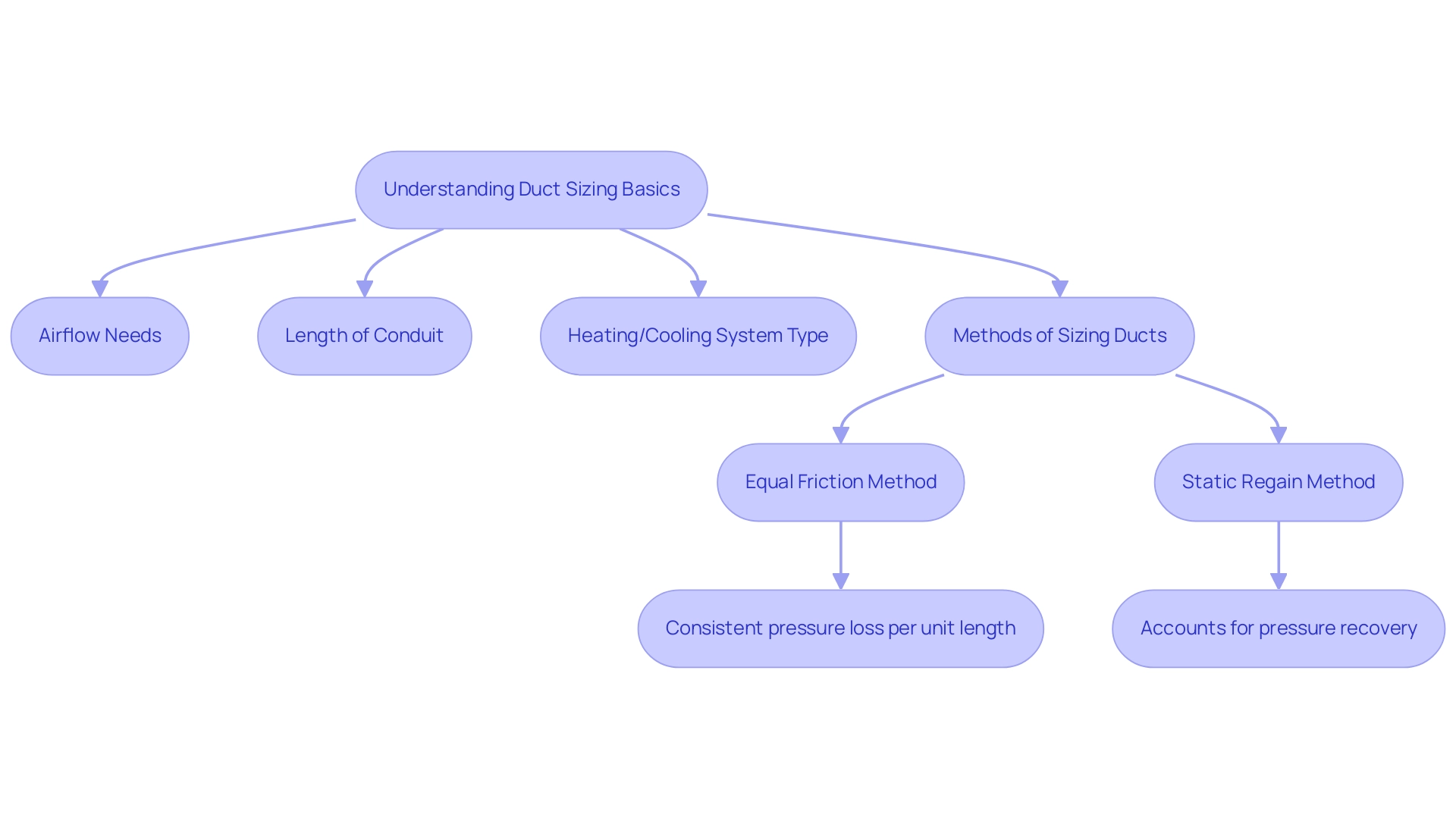Overview
The article provides a comprehensive step-by-step guide on how to use an air duct size calculator effectively, emphasizing the importance of accurate measurements for HVAC system efficiency. It details the necessary information to gather, the calculation process, and the impact of duct sizing on airflow, comfort, and equipment longevity, thereby illustrating how proper sizing can prevent inefficiencies and enhance overall system performance.
Introduction
In the realm of HVAC systems, the importance of accurate duct sizing cannot be overstated. Properly sized ducts ensure efficient airflow, which is critical for maintaining comfort, reducing energy costs, and extending the lifespan of equipment. This article delves into the essential elements of duct sizing, exploring the factors that influence it, the methods and tools available for calculating sizes, and the best practices that HVAC professionals should adopt.
By understanding the nuances of duct sizing, including the impact of airflow requirements and static pressure, readers will gain insights into optimizing HVAC performance and enhancing indoor air quality.
Whether through manual calculations or advanced software solutions, mastering duct sizing is a fundamental skill that can lead to significant improvements in system efficiency and occupant comfort.
Understanding Duct Sizing Basics
The dimensions of the air passage, which can be determined with , are affected by multiple essential elements such as airflow needs, length of the conduit, and the particular kind of heating and cooling system used. Airflow is quantified in cubic feet per minute (CFM), a vital metric that determines how effectively air circulates within a space. Moreover, understanding static pressure is essential, as it directly impacts air movement through the ductwork.
High static pressure can hinder airflow, resulting in inefficiencies in cooling and heating. It is important to note that HVAC units require a minimum of 15 – 20 minutes of average run times to affect humidity levels, which further emphasizes the significance of appropriate sizing for operational efficiency. To accurately size channels, professionals typically utilize an air duct size calculator along with two primary methods:
The equal friction approach maintains a consistent pressure loss per unit length, making it straightforward to implement, while the static regain method accounts for pressure recovery within the setup, allowing for greater flexibility in design. As HVAC specialist Andy Boyarsky remarked, ‘Roberto just arrived and performed a very comprehensive maintenance task on our system,’ emphasizing the importance of upkeep in ensuring optimal system performance. Mastery of these measurement techniques, alongside awareness of static pressure factors, will significantly improve your proficiency in using air duct size calculators effectively.
As demonstrated in the case study titled ‘Material Impact on Airflow’, the choice of ventilation materials—such as flexible tubing versus rigid sheet metal—can greatly influence airflow resistance and static pressure. This highlights the importance of accurate channel dimensions for optimal performance, as the appropriate materials can alleviate airflow problems and enhance overall efficiency.

Step-by-Step Guide to Using a Duct Size Calculator
- Gather Required Information: Before using , it is essential to compile necessary data, including the total airflow required for the space, measured in cubic feet per minute (CFM), the length of the pipe run, and any fittings or bends present in the system. This foundational information is critical for accurate calculation. For example, a bedroom typically requires 5-6 air changes per hour (ACH), which can guide the CFM input for optimal airflow.
- Input the airflow data by entering the CFM into the air duct size calculator. This variable directly affects channel sizing and is a crucial element in guaranteeing optimal airflow within the network. As Rob ‘Doc’ Falke, president of National Comfort Institute, Inc., notes, “Knowing how to maximize system performance isn’t easy to come by, but the best contractors and technicians spend time with their faces buried in their manufacturer’s engineering publications.”
- Select Material: Choose the material you intend to use—options may include galvanized steel or flexible tubing. The type of material selected can impact the sizing due to variations in resistance and airflow characteristics.
- Adjust for Airway Length and Fittings: Input the total length of the airway and account for any additional fittings or bends. These elements increase airflow resistance and must be considered for precise calculations.
- Calculate Duct Size: After entering all relevant information, initiate the calculation using the air duct size calculator by clicking the ‘Calculate’ button. The calculator will then provide the suggested channel size based on the data supplied.
- Review Recommendations: Scrutinize the output to ensure that the suggested duct size is compatible with your HVAC specifications and meets the spatial requirements. Overlooking appropriate dimensions can result in problems, as demonstrated in a case study where a hotel encountered high head pressure and insufficient moisture removal because of flawed design. Proper alignment of these factors is crucial for system efficiency and efficacy.
Exploring Tools and Methods for Duct Sizing
Determining the correct duct size is crucial for ensuring efficient air conditioning, and HVAC professionals have several methods and tools at their disposal:
- Manual Calculation: This traditional approach employs duct sizing charts and formulas to ascertain the appropriate duct size, relying on variables such as airflow and static pressure. While effective, manual calculations can be time-consuming and prone to human error.
- Ventilation System Design Software: An increasing amount of contractors in heating and cooling use specialized software tools that simplify the ventilation system dimensioning process. These tools automate calculations, enabling rapid and precise measurement, thus reducing the likelihood of errors and enhancing productivity. As mentioned by freelance author Patti Feldman, “The application of ductwork sizing software can greatly enhance the precision of heating and cooling installations, guaranteeing that systems function effectively.”
- Air Duct Size Calculator: Numerous websites offer free online duct size calculators, providing technicians in heating, ventilation, and air conditioning a handy resource. By entering basic input data into the air duct size calculator, users can quickly obtain size recommendations, making it a practical option for on-the-spot assessments.
- Mobile Apps: The advent of mobile technology has led to the development of applications specifically designed for heating, ventilation, and air conditioning professionals. These apps enable size calculations directly from smartphones, significantly enhancing convenience and efficiency in the field.
Integrating these tools not only improves accuracy but also aids the industry’s transition towards more efficient methods in heating, ventilation, and and installation. With the heating and cooling sector experiencing trends such as the incorporation of smart home technology and energy-efficient designs, as emphasized in the case study on key trends in the industry, the adoption of advanced air distribution techniques becomes increasingly relevant. Additionally, heating and cooling contractors should consider the cost of these tools; for instance, Buildertrend’s monthly subscription model starts at $499/month, which may be a worthwhile investment for improving operational efficiency.
The Importance of Accurate Duct Sizing
Precise ventilation channel dimensions are crucial for the best operation of HVAC units for various important reasons:
- Efficiency: Appropriately sized channels guarantee effective airflow, lessening the burden on the HVAC unit. When conduits are incorrectly sized, the system must work harder, leading to increased energy costs. In fact, changing air filters every few months can lower air conditioner energy usage by 5 to 15%, highlighting the significance of ensuring airflow quality alongside appropriate channel dimensions. Furthermore, our company provides a complimentary assessment for our services, guaranteeing that you can obtain precise measurements without any initial expenses.
- Comfort: Exact measurements directly influence the distribution of heating and cooling throughout a structure. Incorrect pipe dimensions can lead to inconsistent temperatures, resulting in discomfort in different areas. This inconsistency can result in discontent among residents, further highlighting the necessity for accurate calculations.
- Equipment Longevity: subjected to excessive pressure due to incorrect ventilation measurements may face more frequent failures. This not only shortens the lifespan of the equipment but also leads to higher maintenance costs over time. According to the U.S. Department of Energy, installation errors can decrease heating and cooling system efficiency by as much as 30%. This underscores the essential function that precise dimensions have in overall system health, emphasizing that an air duct size calculator is a fundamental element for achieving correct channel measurements and efficient installation.
- Air Quality: Insufficient airflow due to incorrect channel measurements can greatly jeopardize indoor air quality. Pollutants and allergens may not be effectively filtered, leading to health issues and further discomfort for occupants. Recent research has shown that inadequate channel dimensions can worsen these issues, making it crucial for heating and cooling specialists to utilize an air duct size calculator to emphasize precise measurements. The effect of air channel dimensions goes beyond simple figures; it affects the comfort, efficiency, and health of indoor environments. As demonstrated in the case study on building commissioning, ensuring that climate control units are installed and operate as intended through effective commissioning can lead to enhanced performance and compliance with design specifications. Efficient commissioning is closely linked to precise channel measurements, as it confirms that the system functions within its intended parameters. In 2024, as knowledge of indoor air quality increases, the importance of precise ventilation measurements will continue to be a vital subject within the HVAC sector.
Best Practices for Effective Duct Sizing
To achieve efficient channel sizing, adherence to best practices is essential:
- Conduct Load Calculations: Initiate every project with a comprehensive load calculation. This process uses an air duct size calculator to determine the precise cubic feet per minute (CFM) required for each space, ensuring optimal airflow and comfort. Recent trends indicate a growing emphasis on durable materials that enhance system performance and longevity.
- Implement Regular Maintenance: Establish a routine for inspecting and maintaining ductwork. Regular checks help identify and rectify any issues that could compromise airflow efficiency, thus prolonging the lifespan of the air conditioning system.
- Consult with Professionals: When uncertainties arise, seek guidance from HVAC professionals or leverage advanced software solutions. The software provides accuracy through detailed result outputs and advanced options for efficient pipe configuration, enabling technicians to enhance channel design based on essential parameters like maximum velocity and pressure drop. This expertise is crucial for ensuring balanced pressure and , ultimately preventing AC problems and minimizing wear and tear on equipment. Furthermore, utilizing an air duct size calculator can assist in calculating duct dimensions based on airflow rate and friction loss, ensuring accuracy in sizing.
- Learn from Case Studies: Correctly sizing ducts is vital for preventing AC problems and extending the unit’s lifespan by reducing wear and tear. Professional technicians use specific calculations to ensure balanced pressure and optimal air distribution, as highlighted in the case study titled correct sizing.
Conclusion
Accurate duct sizing is a cornerstone of effective HVAC system performance, directly influencing efficiency, comfort, equipment longevity, and indoor air quality. Understanding the fundamental principles of duct sizing, such as airflow requirements, static pressure, and the impact of duct materials, is essential for HVAC professionals. Utilizing methods like the equal friction and static regain approaches, as well as leveraging modern tools such as duct sizing software and calculators, can streamline the process and enhance precision.
Implementing best practices, including:
- Conducting thorough load calculations
- Selecting high-quality materials
- Maintaining regular inspections
will further optimize duct performance. The importance of consulting experienced professionals and learning from real-world case studies cannot be overstated, as these strategies contribute to a well-functioning HVAC system that meets the needs of occupants while minimizing energy costs.
As the HVAC industry continues to evolve, the emphasis on accurate duct sizing will remain paramount. By prioritizing these principles and practices, professionals can ensure that their systems operate efficiently, providing comfort and maintaining high indoor air quality while extending the lifespan of HVAC equipment.
Frequently Asked Questions
What factors influence the sizing of air ducts?
The dimensions of air ducts are influenced by airflow needs, the length of the conduit, and the type of heating and cooling system used.
How is airflow measured, and why is it important?
Airflow is measured in cubic feet per minute (CFM), which is a critical metric for determining how effectively air circulates within a space.
What is static pressure, and how does it affect airflow?
Static pressure is the resistance to airflow in the ductwork. High static pressure can hinder airflow, leading to inefficiencies in heating and cooling.
How long should HVAC units run to affect humidity levels?
HVAC units require a minimum run time of 15 to 20 minutes to effectively impact humidity levels.
What methods do professionals use to size air ducts?
Professionals typically use an air duct size calculator along with two primary methods: the equal friction method and the static regain method.
What is the equal friction method?
The equal friction method maintains a consistent pressure loss per unit length, making it straightforward to implement.
What is the static regain method?
The static regain method accounts for pressure recovery within the duct system, allowing for greater flexibility in design.
How do ventilation materials affect airflow?
The choice of ventilation materials, such as flexible tubing versus rigid sheet metal, can significantly influence airflow resistance and static pressure.
What initial information is needed before using an air duct size calculator?
Required information includes total airflow in CFM, the length of the pipe run, and any fittings or bends present in the system.
What should be done after inputting data into the air duct size calculator?
After entering the relevant information, you should click the ‘Calculate’ button to obtain the suggested duct size based on the provided data.
Why is it important to review the recommendations from the air duct size calculator?
Reviewing the output ensures that the suggested duct size is compatible with HVAC specifications and meets spatial requirements, preventing potential issues like high head pressure or insufficient moisture removal.
List of Sources
- Understanding Duct Sizing Basics
- servicetitan.com (https://servicetitan.com/tools/hvac-duct-calculator)
- Basic Ductwork Guide: How to Design Your Duct System (https://pinpointair.com/post/how-to-design-a-duct-system)
- HVAC Duct Sizing Rule Of Thumb – Aztil AC (https://aztilac.com/hvac-duct-sizing-rule-of-thumb)
- Step-by-Step Guide to Using a Duct Size Calculator
- How Much Heating Airflow? (https://contractingbusiness.com/residential-hvac/article/20870572/how-much-heating-airflow)
- HVAC CFM Calculator | Airflow Rate Calculation (https://servicetitan.com/tools/hvac-cfm-calculator)
- CFM per ton range (https://hvac-talk.com/vbb/threads/119415-CFM-per-ton-range)
- Exploring Tools and Methods for Duct Sizing
- buildops.com (https://buildops.com/resources/best-hvac-software)
- Design programs for HVAC sizing solutions (https://contractormag.com/management/article/20873476/design-programs-for-hvac-sizing-solutions)
- sbeodyssey.com (https://sbeodyssey.com/blog/hvac-industry)
- Top HVAC Estimating Software in 2025 (https://slashdot.org/software/hvac-estimating)
- The Importance of Accurate Duct Sizing
- The Impact of Different Types of Ductwork on Energy Bills (https://coolproatlanta.com/types-of-ductwork-on-energy-bills)
- Heating, Ventilation and Air-Conditioning Systems, Part of Indoor Air Quality Design Tools for Schools | US EPA (https://epa.gov/iaq-schools/heating-ventilation-and-air-conditioning-systems-part-indoor-air-quality-design-tools)
- arcticac.com (https://arcticac.com/blog/statistics-hvac-energy-consumption)
- Best Practices for Effective Duct Sizing
- How To Calculate Duct Size: A Comprehensive Guide from h2x (https://h2xengineering.com/blogs/calculate-duct-size)
- eng-tips.com (https://eng-tips.com/threads/duct-sizing.55661)
- servicetitan.com (https://servicetitan.com/tools/hvac-duct-calculator)
- jjheat.com (https://jjheat.com/blog/hvac-duct-sizing-rule-of-thumb)





